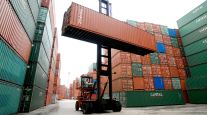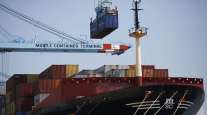August Intermodal Surge Tops Pre-Recession Levels
This story appears in the Sept. 6 print edition of Transport Topics.
Intermodal freight continued to surge during August, topping pre-recession levels and reaching the highest point this year, driven by a combination of domestic and international growth, experts said.
In the week ended Aug. 21, the number of shipments reached 236,404 — a 22% improvement over 2009, and 2.6% more than in the comparable week of 2008.
That marked the second time in four weeks that this year’s intermodal volume as compiled by the Association of American Railroads topped the comparable period two years earlier, before the recession ravaged freight levels.
Rail/truck freight exceeded last year in every week of 2010.
“Some truck freight has gone over to rail,” Dan Keen, assistant vice president of policy analysis, at AAR, told Transport Topics on Aug. 31. “Truck capacity has been taken out, and the price of trucking has been rising as the economy has recovered to the extent that it has.”
“Hopefully, the intermodal business overall will come back further and accelerate,” Keen added.
Larry Gross, a former intermodal industry executive and now a senior consultant at FTR Associates, pinpointed another reason for the recent growth.
He said concern about a chronic international container shortage prompted shippers to move cargo to the United States earlier than the usual peak shipping season.
Gross said he is expecting what he called a “muted peak” freight season, with growth from July to August and August to September that should be slower than past years because of the earlier surge in international cargo.
“I don’t see this as a negative sign,” he said. “It isn’t a sign that the economy is weakening. There was an early peak because of the container shortage.”
“It is going to be a very satisfactory peak season for intermodal,” Gross said. “It won’t be a barn burner. We are not seeing any sign of an economic downturn in the intermodal figures.”
“We still had a good July,” he added, though the growth pace slowed from May and June performance. “Even if intermodal wasn’t growing very fast, you should expect month-to-month volume improvement.”
Over the first 33 weeks of 2010, intermodal traffic topped 2008 levels once in March and twice during weeks when the timing of the Memorial Day and July 4 holidays affected the flow of freight and skewed year-to-year comparisons.
Gross and Keen both agreed that freight railroads’ domestic intermodal growth was leading to a rise in market share for intermodal.
“On the domestic side, intermodal is just tracing a really nice seasonal trend,” Gross said.
“Some truck freight has gone over to rail,” Keen said. “Rail service now reportedly is really, really good, which has helped drive the conversions as well.”
How much of a shift from truck to intermodal was difficult to judge, Keen said, because there are no comprehensive statistics to track the changes.
While there are no specific market-share statistics, FTR and rail data show that intermodal shipments still remain well below about 10% of total moves traveling more than 550 miles.
Keen said that total container shipments, including both domestic and international, continue to drive the overall volume gains. Intermodal freight in that equipment has risen 17% this year, compared with a 1.5% increase in trailers from a year earlier.
The intermodal equipment picture is brightening, too.




